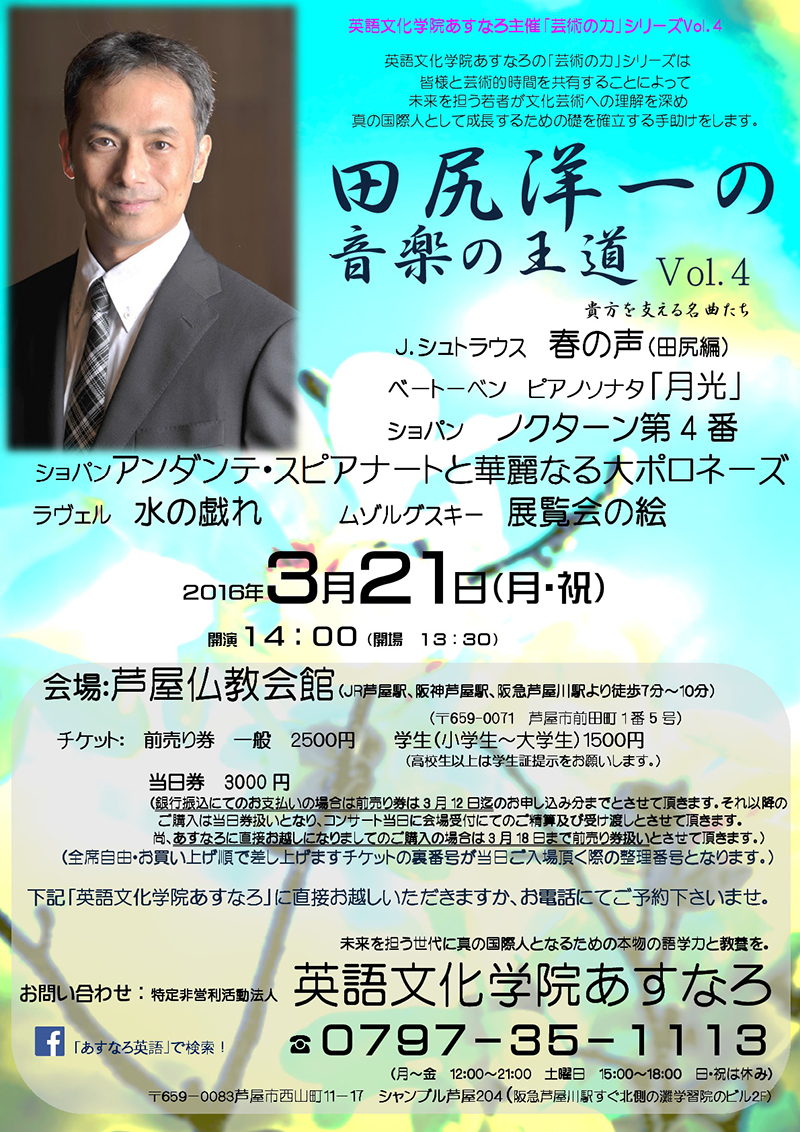芸術の力シリーズ「音楽の王道」
- TOP
- 文化芸術活動ー国際人育成のために
- 芸術の力シリーズ「音楽の王道」
未来を担う若い世代が
文化芸術により深く触れるための企画
「音楽の王道」
あすなろは、英語教育だけでなく、生徒が真の国際人として成長するための教育も目的としています。その一環として、広く文化芸術に触れ、理解を深める企画を行っています。
その一つ「音楽の王道」は、田尻洋一さんの演奏を通して皆様と芸術的時間を共有します。あすなろの生徒は曲の背景や歴史を学び、英語と日本語で曲目解説をします。当日の会場スタッフも担当し、普段はあまり接する機会のない、世代の違うお客様の力を借りて、社会性を養います。
こうして、大人になるまでに知っておくべき名曲の数々をしっかりと心に刻み込むと同時に、素晴らしい経験を積んで行きます。
もちろんコンサートは、一般のお客様にもお楽しみいただけます。ご興味のある方はお電話にてお問い合わせ下さい。
尚、下記は2017年5月28日「音楽の王道」Vol.6、2016年3月21日「音楽の王道」Vol.4コンサートのチラシと、生徒の曲目解説です。生徒たちの力作を是非ご覧下さい!

★シューマン:幻想曲
解説/Y.I(高1)
この「幻想曲」は1838年にロベルト・シューマンによって書かれた曲です。シューマンはピアニスト、作曲家としてデビューしましたが、過度な練習により指を痛めて、ピアニストの道を断念しました。作曲家としての道を歩む中で、恩師の娘クララ・ヴィークと熱烈な恋愛関係に陥ります。当時クララは 大変有名なピアニストでした。恩師の激しい妨害を乗り越えてクララと結婚しますが、徐々に精神の不安に苛まれます。最期は錯乱の末に自殺未遂を起こし、精神病院で生涯を閉じました。この曲はベートーヴェンを讃える曲です。そのため曲中にベートーヴェンの作品が引用されています。 それと同時に、クララとの恋愛状況も強く反映されています。
‘Fantasia’ was composed in 1838 by Robert Schumann. Robert Schumann began as a pianist and a composer. But he gave up his career as a pianist because he broke his fingers by excessive practice. While studying to become a composer, he fell in love with his former teacher’s daughter Clara Wieak. She was a famous pianist. He married her in spite of her father’s interference. Schumann was suffering from depression and it was gradually worsening. He attempted suicide because of it, and finally he died in a mental hospital. Schumann composed this piece to express his admiration towards Beethoven. So parts of Beethoven’s music are used in this piece. In addition, the piece reflects his feelings toward Clara.
★フォーレ:シシリエンヌ
解説/Y.T(高2)
シシリエンヌというのはシチリア島を意味しています。作者はガブリエル・フォーレというフランスの作曲家です。彼はこの曲がお気に入りだったようで、元々1893年に他の劇のために作られたものでしたが、後に『ペアレストメリザンド』というフォーレの管弦楽作品の傑作となった劇の中の曲の一つに再び使われました。これは、とても神秘的な曲です。静かなのに、なぜか情熱を感じさせる美しいメロディーです。フォーレが気に入った理由がよく分かります。なぜなら聞いていている人々に「ずっと居たい」と思わせるような空間を生み出す力をこの曲は持っているのですから。どうぞ耳だけではなく、感覚をすべて使って音の一つ一つを聴いてください。そして音以上のものを感じ取ってください。
Sicilienne comes from the name of the island Sicily. It was written by a French composer, Gabriel Faure. He loved it so much that he used it in a play ‘’Pelleas and Melisand’’, though it was composed for another play, and this piece became a masterpiece of orchestral music. This piece is really spiritual. It is not only quiet but also passionate and both features contribute to its beautiful melody. No wonder Faure loved it so much. It has the power to create a comfortable atmosphere. Please listen to it not only with your ears but also with your heart. Then you can feel something special.
★ベートーベン:ピアノソナタ「月光」
解説/Y.I(中2)
「月光」はベートーベンのピアノソナタ曲の中でも、もっとも広く親しまれている1802年の作品です。特に第一楽章のメロディーはよく知られています。題名のうちベートーベンが書き記したのは「幻想曲風ソナタ」という部分だけであり、「月光」の呼び名は詩人ルートヴィヒ・レルシュターブのコメント、「ルツェル湖の月光の波に揺らぐ小舟のよう」から採られています。当時、ベートーベンがピアノを教えていた伯爵令嬢のジュリエッタ・グイチャルディに捧げるために作曲したものの、失恋してしまったというエピソードが伝えられています。
“Moonlight Sonata” is one of the most famous piano sonatas Beethoven composed. The melody in the first movement is especially popular. This piece was composed in 1802. Beethoven named this sonata “Fantasia Sonata”. The name “Moonlight sonata” has been taken from the following phrase by the poet Ludwing Rellsttab: “As a boat shaken by the moonlight on the Lake Lucerne.” It is said Beethoven composed it to dedicate to Countess Giulietta who was one of his piano pupils, but he failed in love with her.
★ショパン:アンダンテ・スピアナートと華麗なる大ポロネーズ
解説/S.H(高2)
この曲はもともとピアノとオーケストラのための作品で、フレデリック・ショパンの管弦楽とピアノによって演奏される協奏曲です。1831年に前奏としてピアノ独奏「アンダンテ・スピアナート」が作曲されました。スピアナートというのは、イタリア語で「滑らか」という意味で明るい曲調がこの曲の特徴です。またポロネーズとはフランス語で「ポーランド風」という意味で、マズルカと並び、ポーランド起源のダンスまたはそのための舞曲のことです。最近ではオーケストラ部を伴わない独奏だけでも十分音楽として体裁が整っていることから、ピアノ独奏で演奏されることが多いです。
This music is originally composed for piano and string orchestra by Frederic Chopin. “Polonaise” for piano was composed in 1831. After that, “Andante Spianato” was composed as an introduction for this piece in 1834. Then, this music was published in its current form. ”Spianato” means “smooth” in Italian . So this music is very bright. Also Polonaise means “Poland style” in French. This music is dance music of Poland. Nowadays, this piece is often played only with the piano because its sound is sufficient as formal music without orchestra.
★ラヴェル:「水の戯れ」
解説/A.F(中2)
「水の戯れ」は、フランスの作曲家であるモーリス・ラヴェルが、パリ音楽院在学中の1901年に作曲した曲です。楽譜の冒頭に、「水にくすぐられて笑う河神」というアンリ・ド・レニエの詩の一節が書かれていて、噴水のような美しい水の動きを描いています。ラヴェルは、スペインに近いフランスで生まれたため、スペインとフランス両方の影響を受けています。彼は、7歳でピアノを始め、22歳の時に作曲家として公式デビューを果たし、数多くのピアノ曲を残しました。その中でも特に有名な曲が「ボレロ」です。しかし、彼はこの曲を作曲した4年後、交通事故に遭い、晩年、この影響で記憶障害が悪化し、満足に文字を書くことすらままならず、作曲も出来なくなってしまいました。そして、友人に泣きながら、「私の頭の中にはたくさんの音楽が豊かに流れている。それをもっとみんなに聴かせたいのに、もう1文字も書けなくなってしまった。」と嘆きました。その後、脳手術を受けますが昏睡状態に陥り、62歳で息を引き取りました。
“Jeux d’eau” was composed by a French composer, Maurice Ravel, while he was studying at Conservatoire de Paris in 1901. A piece of poetry, “Laughing God Who is Tickled by Water” by Henri de Regnier was written at the beginning of the score. It expresses the beautiful movement of water like a fountain. Ravel was influenced by both Spanish and French cultures because he was born in a village in France which was quite close to the border of Spain. When he was seven years old, he began to play the piano, and he made a debut as a composer at the age of twenty-two. He left many pieces. “Bolero” is especially famous among them. But four years later when he composed it, he had a traffic accident and had a memory problems because of theaftereffects of it. Late in his life, it was getting worse. He couldn’t write properly and he also couldn’t compose any more. He wept to his friend, “A lot of melodies are being played in my head. I want everybody to hear them, but I can’t compose any more”. After that, though he had an operation on his brain, he went into a coma, and he died when he was sixty-two years old.
★ムゾルグスキー:展覧会の絵
解説/Y.H(高2)
これは1874年にロシアの作曲家ムゾルグスキーによって作曲されたピアノ曲です。この曲は友人であったロシア出身の建築家、画家のハルトマンの遺作展を歩きながら、そこで見た10枚の絵の印象を音楽にしたものです。ロシアのみならずフランス、ローマ、ポーランドなど様々な国の風物が書かれています。また、10枚の絵が無秩序に並んでいるのではなく絵と絵の間に自身の歩く姿を表現した間奏曲を入れています。それぞれの曲の題名となっている順番は次の通りです。
- プロムナード
- 地底の小人
- プロムナード
- 古城
- プロムナード
- チュイルリーの庭
- ビドロ
- プロムナード
- 卵の殻を付けた雛の踊り
- サムエルゴールデンベルクとシュムイレ
- プロムナード
- リモージュの市場
- カタコンベ(死せる言葉による死者への呼びかけ)
- 鶏の足の上に立つ小屋
- キエフの大門
This piano piece was composed by Russian composer Mussorgsky in 1874. It expresses the image of walking in the museum to see the exhibition of posthumous works from Hartman who was a Russian artist and an architect. Mussorgsky composed the music from his impression of ten pictures. These are pictures of France, Rome and Poland. And the ten pictures aren’t lined chaotically. “Promenade” which expresses walking between one picture and another is inserted. The themes of pieces are below.
- Promenade
- The Gnome
- Promenade
- The Old Castle
- Promenade
- Tuileries
- Cattle
- Promenade
- The Ballet of Unhatched Chicks in their Shells
- Samuel Goldenberg and Schmuyle
- Promenade
- The Market at Limoges (The Great News)
- Catacombs
- The Hut on Fowl’s Legs
- The Great Gate of Kiev

